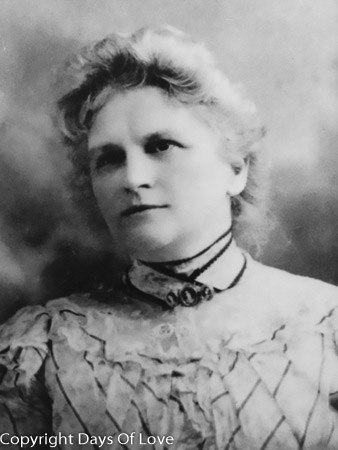
Queer Places:
Academy of the Sacred Heart, 619 N 2nd St, St Charles, MO 63301, Stati Uniti
4232 McPherson Ave, St Louis, MO 63108, USA
Calvary Cemetery and Mausoleum, 5239 W Florissant Ave, St. Louis, MO 63115, Stati Uniti
 Kate Chopin,[1] born Katherine O'Flaherty (February 8, 1850 – August 22, 1904), was an American author of short stories and novels based in Louisiana. She is now considered by some scholars [2] to have been a forerunner of American 20th-century feminist authors of Southern or Catholic background, such as Zelda Fitzgerald.
Kate Chopin,[1] born Katherine O'Flaherty (February 8, 1850 – August 22, 1904), was an American author of short stories and novels based in Louisiana. She is now considered by some scholars [2] to have been a forerunner of American 20th-century feminist authors of Southern or Catholic background, such as Zelda Fitzgerald.
Of maternal French and paternal Irish descent, Chopin was born in St. Louis, Missouri. She attended the Academy of the Sacred Heart where she met her lifelong friend, Kitty Garesche. She married and moved with her husband to New Orleans. They later lived in the country in Cloutierville, Louisiana. From 1892 to 1895, Chopin wrote short stories for both children and adults that were published in such national magazines as ''Atlantic Monthly'', ''Vogue'', ''The Century Magazine'', and ''The Youth's Companion.'' Her stories aroused controversy because of her subjects and her approach; they were condemned as immoral by some critics.
Her major works were two short story collections: ''Bayou Folk'' (1894) and ''A Night in Acadie'' (1897). Her important short stories included "Désirée’s Baby" (1893), a tale of miscegenation in antebellum Louisiana,[3] "The Story of an Hour" (1894),[4] and "The Storm"(1898). "The Storm" is a sequel to "At the Cadian Ball," which appeared in her first collection of short stories, ''Bayou Folk.''
Chopin also wrote two novels: ''At Fault'' (1890) and ''The Awakening'' (1899), which are set in New Orleans and Grand Isle, respectively. The characters in her stories are usually residents of Louisiana. Many of her works are set in Natchitoches in north central Louisiana, a region where she lived.
Within a decade of her death, Chopin was widely recognized as one of the leading writers of her time.[5] In 1915, Fred Lewis Pattee wrote, "some of [Chopin's] work is equal to the best that has been produced in France or even in America. [She displayed] what may be described as a native aptitude for narration amounting almost to genius."
Chopin was born Katherine O'Flaherty in St. Louis, Missouri. Her father, Thomas O'Flaherty, was a successful businessman who had immigrated to the United States from Galway, Ireland. Her mother, Eliza Faris, was his second wife and a well-connected member of the ethnic French community in St. Louis; she was the daughter of Athénaïse Charleville, who was of French Canadian descent. Some of Chopin's ancestors were among the first European (French) inhabitants of Dauphin Island, Alabama.
Kate was the third of five children, but her sisters died in infancy and her half-brothers (from her father's first marriage) died in their early twenties. They were reared Roman Catholic, in the French and Irish traditions. After her father's death in 1855, Chopin developed a close relationship with her mother, maternal grandmother, and great-grandmother. She also became an avid reader of fairy tales, poetry, and religious allegories, as well as classic and contemporary novels. She graduated from Sacred Heart Convent in St. Louis in 1868.[6]
In St. Louis, Missouri, on 8 June 1870,[7] she married Oscar Chopin and settled with him in his home town of New Orleans, an important port. Chopin had six children between 1871 and 1879: in order of birth, Jean Baptiste, Oscar Charles, George Francis, Frederick, Felix Andrew, and Lélia (baptized Marie Laïza).[8] In 1879, Oscar Chopin's cotton brokerage failed.
The family left the city and moved to Cloutierville in south Natchitoches Parish to manage several small plantations and a general store. They became active in the community, and Chopin absorbed much material for her future writing, especially regarding the culture of the Creoles of color of the area.
When Oscar Chopin died in 1882, he left Kate with $42,000 in debt (approximately $420,000 in 2009 money). According to Emily Toth, "for a while the widow Kate ran his [Oscar's] business and flirted outrageously with local men; (she even engaged in a relationship with a married farmer)."[9] Although Chopin worked to make her late husband's plantation and general store succeed, two years later she sold her Louisiana business.
Her mother had implored her to move back to St. Louis, and Chopin did, aided by her mother's assistance with finances. Her children gradually settled into life in the bustling city of St. Louis. The following year, Chopin's mother died.[10]
Chopin struggled with depression after the losses in a short time of both her husband and her mother. Her obstetrician and family friend, Dr. Frederick Kolbenheyer, suggested that she start writing, believing that it could be a source of therapeutic healing for her. He understood also that writing could be a focus for her extraordinary energy, as well as a source of income.[11]
By the early 1890s, Kate Chopin began writing short stories, articles, and translations which were published in periodicals, including the ''St. Louis Post-Dispatch'' newspaper. She was quite successful and placed many of her publications in literary magazines. At the time, she was considered only as a regional local color writer, as this was a period of considerable publishing of folk tales, works in dialect, and other elements of Southern folk life. Chopin's strong literary qualities were overlooked.
In 1899, her second novel, ''The Awakening,'' was published. It generated a significant amount of negative press because its characters, especially the women, behaved in ways that conflicted with current standards of acceptable ladylike behavior. People considered offensive Chopin's treatment of female sexuality, her questions about the virtues of motherhood, and showing occasions of marital infidelity.[12] At the same time, some newspaper critics reviewed it favorably.[13]
This, her best-known work, is the story of a woman trapped in the confines of an oppressive society. It was out of print for several decades, as literary tastes changed. Rediscovered in the 1970s, when there was a wave of new studies and appreciation of women's writings, the novel has since been reprinted and is widely available. It has been critically acclaimed for its writing quality and importance as an early feminist work of the South.[14]
Critics suggest that such works as ''The Awakening,'' were too far ahead of their time and therefore not socially embraced. After almost 12 years of publishing and shattered by the lack of acceptance, Chopin, deeply discouraged by the criticism, turned to short story writing. In 1900, she wrote "The Gentleman from New Orleans." That same year she was listed in the first edition of ''Marquis Who's Who.'' However, she never made much money from her writing, and had to depend on her investments in Louisiana and St. Louis (aided by her inheritance from her mother) to support her.
While visiting the St. Louis World's Fair on August 20, 1904, Chopin suffered a brain hemorrhage. She died two days later, at the age of 54. She was interred in Calvary Cemetery in St. Louis.
My published books:


BACK TO HOME PAGE

https://en.wikipedia.org/wiki/Kate_Chopin


 Kate Chopin,[1] born Katherine O'Flaherty (February 8, 1850 – August 22, 1904), was an American author of short stories and novels based in Louisiana. She is now considered by some scholars [2] to have been a forerunner of American 20th-century feminist authors of Southern or Catholic background, such as Zelda Fitzgerald.
Kate Chopin,[1] born Katherine O'Flaherty (February 8, 1850 – August 22, 1904), was an American author of short stories and novels based in Louisiana. She is now considered by some scholars [2] to have been a forerunner of American 20th-century feminist authors of Southern or Catholic background, such as Zelda Fitzgerald.